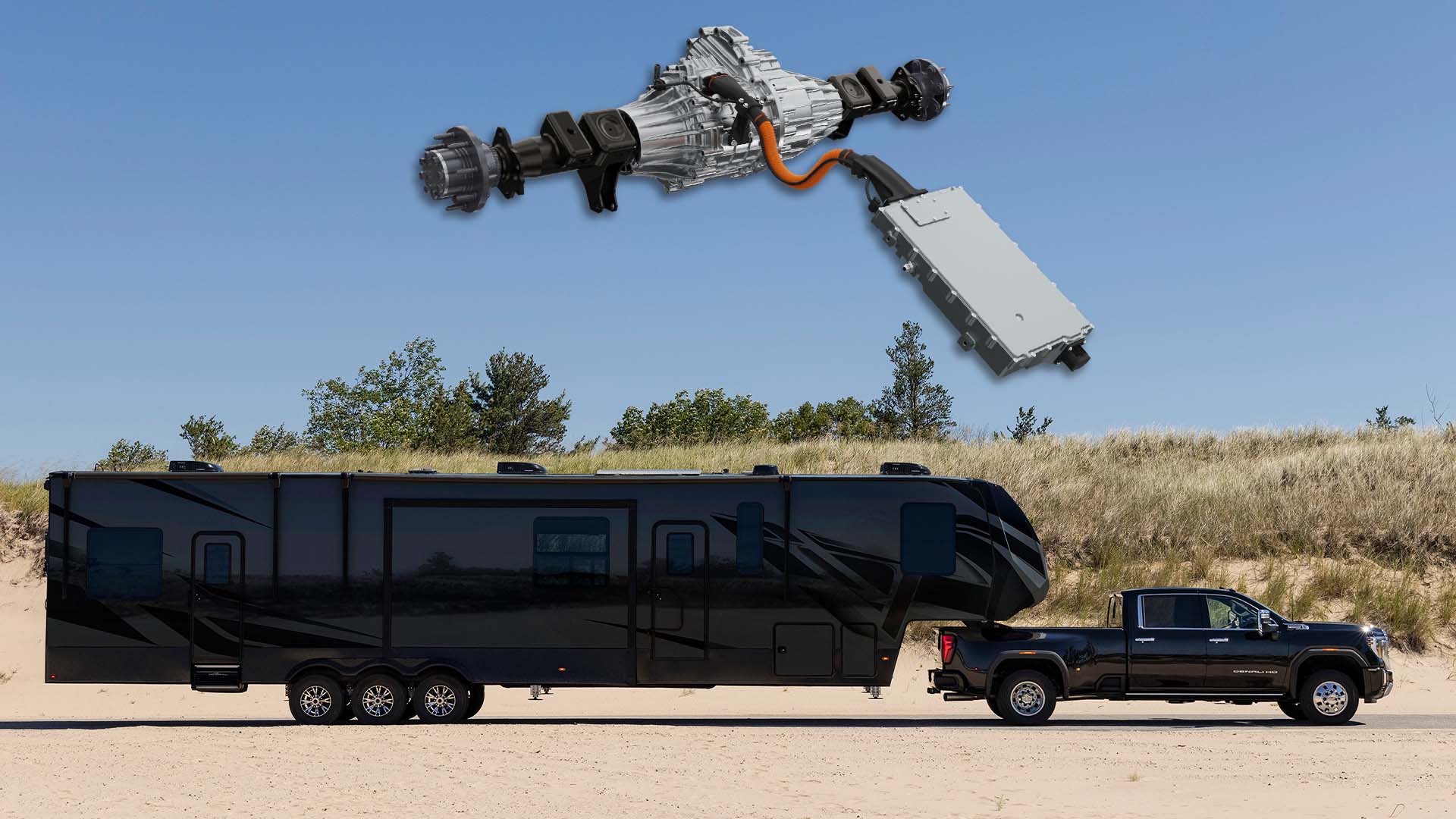

As more electric trucks hit the market, right now the big conversation is all about range, especially while towing. A BEV pickup just won’t work for some drivers until they can pull a trailer long distances without spending hours charging along the way. But there’s a second layer to this discussion not getting enough attention, and that’s how exactly they’ll tow anything heavier than a conventional trailer. So far, every electric truck we’ve seen has independent rear suspension. It provides a comfy ride, but also makes fifth-wheel and gooseneck towing impossible. That’s a problem.
Bed-mounted hitches exist because placing the weight of a heavy trailer directly over the rear axle better distributes those forces across the truck’s frame and suspension than a Class IV bumper hitch. Without a solid rear axle, as has been the standard forever, a truck can’t effectively shoulder that load. This is particularly critical for three-quarter-ton and one-ton pickups. Plenty of Ram 2500 or Ford F-350 need the ability to tow big loads, and plenty more just want to know they can.
The good news is manufacturers seem to get that as antiquated as solid axles might seem to some, they have to stick around when electric HD trucks finally hit the market. And the different concepts for bringing solid axles into the electric age are worth analyzing.




While Ford recently patented its own design with in-hub motors, automotive suppliers like Allison, ZF, and Magna are taking a more direct route that could help speed up the electrification of dually trucks and the like. This involves swapping out the solid axle’s traditional differential in favor of a centrally mounted electric drive unit.
To me, one of the most interesting applications so far is Magna’s scalable eBeam axle. It’s a simpler and potentially cheaper solution for automakers, which could save drivers money as a result. Importantly, it’s built to fit into existing suspension setups, so automakers (or even ambitious fleet owners) can plug it into their current or future models without an extensive redesign.
That’s key because it allows these hard-working trucks to continue operating the way they have for so long, just with the added benefit of diesel-beating instant torque. Mike Dowsett, chief engineer of electrification at Magna over the brand’s Next Drive North America program, explained the benefits to me at length. When I asked if the eBeam can solve the problem of fifth-wheel and gooseneck towing with electric drivetrains, he replied, “Yes. Our eBeam was designed with robustness in mind to not only support these types of weight requirements (physical strength of the axle housings, etc.) but to also sustain these loads over a long period of continuous use.”
Dowsett brings up reliability, which is another sensitive topic when truck owners consider electrification. No one wants to spend big money on incredibly complex components when the warranty runs out, and it’s especially crucial for business owners that use their pickups commercially. Downtime means you’re losing money instead of making it, and it’s not always easy to find another machine that’ll tow 20,000 pounds or more, especially with ongoing supply constraints.
“Magna benchmarked many existing solid axles during the concept phase, and we have significant manufacturing experience of axles globally,” Dowsett continued. “We design to meet or exceed the OEMs’ required specifications, which vary from model to model.”




Another benefit of Magna’s battery-powered solid axle is that it still allows for traditional suspension upgrades, like airbags for load leveling and stability. High-end models such as the Rivian R1T and GMC Hummer EV offer air suspension from the factory, but if you need a truck for work, you’re better off buying something more practical. The aftermarket is scrambling to develop and sell parts for electric trucks with independent rear suspensions, but it’s incredibly time-consuming and expensive. As far as customization goes, F-150 Lightning owners are pretty much stuck with simple leveling kits for the time being as its IRS has proven tricky to mod. Whether you prefer your pickup to be stock or modified, this is important for a lot of owners who want to improve the usability or appearance of their rig.
Finally and maybe most relevantly for the immediate future is the eBeam’s versatility. Not only is it compatible with existing one-ton truck suspensions, but it’s also scalable for half-tons and even Class 6 medium-duty vehicles. This makes it an automotive Swiss army knife of sorts that retains the simple and proven live axle formula while adding electric propulsion. What’s more, it’s usable in hybrid applications so it can be combined with internal combustion engines to ease range anxiety.
All this serves as proof that the key to electrifying tomorrow’s work vehicles is found in perfecting what we have instead of reinventing the wheel, so to speak. IRS will continue to be a great solution for pickups and SUVs that prioritize comfort and daily drivability over outright towing capacity. Electrified solid axles will likely be the answer for the rest who need their truck to make a living—or make cross-country trips with their fifth-wheel camper a breeze.
Got a tip or question for the author? Contact them directly: caleb@thedrive.com